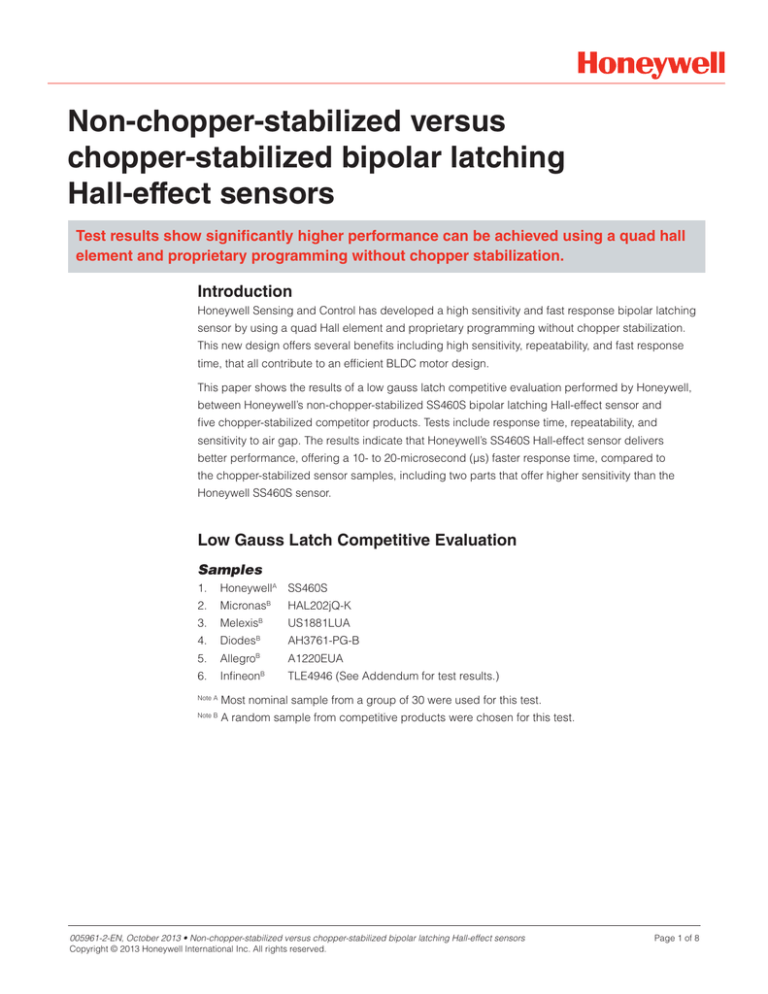
Non-chopper-stabilized versus
chopper-stabilized bipolar latching
Hall-effect sensors
Test results show significantly higher performance can be achieved using a quad hall
element and proprietary programming without chopper stabilization.
Introduction
Honeywell Sensing and Control has developed a high sensitivity and fast response bipolar latching
sensor by using a quad Hall element and proprietary programming without chopper stabilization.
This new design offers several benefits including high sensitivity, repeatability, and fast response
time, that all contribute to an efficient BLDC motor design.
This paper shows the results of a low gauss latch competitive evaluation performed by Honeywell,
between Honeywell’s non-chopper-stabilized SS460S bipolar latching Hall-effect sensor and
five chopper-stabilized competitor products. Tests include response time, repeatability, and
sensitivity to air gap. The results indicate that Honeywell’s SS460S Hall-effect sensor delivers
better performance, offering a 10- to 20-microsecond (µs) faster response time, compared to
the chopper-stabilized sensor samples, including two parts that offer higher sensitivity than the
Honeywell SS460S sensor.
Low Gauss Latch Competitive Evaluation
Samples
1.HoneywellA SS460S
2.MicronasB HAL202jQ-K
3.MelexisB US1881LUA
4.DiodesBAH3761-PG-B
5.AllegroBA1220EUA
6.InfineonB TLE4946 (See Addendum for test results.)
Note A
Most nominal sample from a group of 30 were used for this test.
Note B
A random sample from competitive products were chosen for this test.
005961-2-EN, October 2013 • Non-chopper-stabilized versus chopper-stabilized bipolar latching Hall-effect sensors
Copyright ©
­­ 2013 Honeywell International Inc. All rights reserved.
Page 1 of 8
Test Configuration Setup
A circular target with 48 magnetic pole pairs was used to trigger the product samples. The samples
were placed in the magnetic field as close to each other as possible and centered in the Y-axis (as
shown in Figure 1 and a close-up of the parts shown in Figure 2). The tests were performed at a
0.020 inch air gap.
Figure 1. Circular target
Figure 2. Close-up view
Figure 3. A custom software application was used to precisely control target rotation and
sample position.
All results were measured against a Top Dead Center (TDC) trigger that has a very fast response
time. Using this method, the exact individual target (48 in total on the target wheel) was used for all
measurements, that eliminates the variation between individual targets.
005961-2-EN, October 2013 • Non-chopper-stabilized versus chopper-stabilized bipolar latching Hall-effect sensors
Copyright ©
­­ 2013 Honeywell International Inc. All rights reserved.
Page 2 of 8
Results
Response Time Estimate
To calculate the response time, the target was revolved at various frequencies, clockwise and
counterclockwise, with a 0.020 inch sense gap. The target’s angle of rotation was measured at the
point where the sensor output switched.
Frequency
Direction
Edge 1
Edge 2
Edge 3
Edge 4
Edge 5
500
500
CCW
CW
estimated real edge
transition angle
3.336
3.468
3.402
0.132
7.11
7.271
7.1905
0.161
10.831
10.991
10.911
0.16
14.647
14.751
14.699
0.104
18.379
18.527
18.453
0.148
estimated real edge
transition angle
3.345
3.469
3.407
0.124
7.107
7.265
7.186
0.158
10.838
10.996
10.917
0.158
14.64
14.74
14.69
0.1
18.369
18.529
18.449
0.16
estimated real edge
transition angle
3.343
3.476
3.4095
0.133
7.105
7.273
7.189
0.168
10.818
10.996
10.907
0.178
14.594
14.775
14.6845
0.181
18.357
18.529
18.443
0.172
estimated real edge
transition angle
3.285
3.51
3.3975
0.225
7.065
7.29
7.1775
0.225
10.788
11.017
10.9025
0.229
14.528
14.825
14.6765
0.297
18.313
18.542
18.4275
0.229
1000
1000
2000
2000
4000
4000
CCW
CW
CCW
CW
CCW
CW
When the target is sufficiently slow, the response time is much faster than the moving magnetic field
of the target so the expected latency between the 0 gauss level angle and the angle of the field
detection depends on the test setup and product sensitivity. When the target is faster, the angle
recorded is a combination of the magnetic field latency and the response time of the sensor.
In this example, the Edge 1 results show that the angle of the transition remains fairly stable at the
lower frequencies of 500 RPM to 2000 RPM. At 4000 RPM, the angle shifts due to the response
time of the sensor, increasing about 0.06° over the entire angle of the transition. At 4000 RPM,
0.06° angle is equivalent to 2.5 µs (0.06° /360° /4000 RPM x 60s). Therefore, the estimated
response time is half the transition increase or about 1.25 µs** total.
** Please note that a sensor’s response time is based on target type, air gap, and temperature. This
value is not intended to be used as a specification; it is merely an observed value specific to this
test configuration.
Response to Magnetic Field
The samples were mounted and centered so the two samples − Honeywell’s SS460S and one
competitor product − were in the same magnetic field of the tester and offset from the actual
center of the field by an equal distance. In this configuration, both samples experience the same
environment so that a direct comparison can be made. The target was rotated at 5000 RPM and
multiple scans (approximately 100) were obtained with an oscilloscope to observe the sensor’s
reaction to the target. The waveforms of samples 2, 3, and 4 showed a wide edge, indicating
these samples did not switch at the same point. These results suggest that the competitive sample
devices do not provide repeatable results. The Honeywell sample, as well as samples 5 and 6, did
not show any variation (no heavy white edge), indicating good repeatability.
005961-2-EN, October 2013 • Non-chopper-stabilized versus chopper-stabilized bipolar latching Hall-effect sensors
Copyright ©
­­ 2013 Honeywell International Inc. All rights reserved.
Page 3 of 8
All samples exhibited a slower response time when compared to the Honeywell product. Samples
2, 3, 4, 5, and 6 all exhibited a delay in response time between 10 µs and 30 µs. This delayed
response time is due to the chopper stabilization process.
In all scope graphs below:
•
Honeywell sensor is the top scope trace
•
Competitor device is the lower trace
•
100 sweeps displayed
•
Horizontal scale: 20 µs/grad
•
Vcc = 24 Vdc
•
0.020 in air gap to target
Figure 4. Micronas (Sample 2)
The Micronas sensor sample shows an 8 µs to 32 µs slower response time versus the Honeywell
sensor. Testing also shows a variance in actuation of 20 µs.
Figure 5. Melexis (Sample 3)
Test results show the Melexis sensor has a 13 µs to 30 µs slower response time compared to
Honeywell’s sensor. Testing also shows a variance in actuation of 10 µs to 12 µs.
005961-2-EN, October 2013 • Non-chopper-stabilized versus chopper-stabilized bipolar latching Hall-effect sensors
Copyright ©
­­ 2013 Honeywell International Inc. All rights reserved.
Page 4 of 8
Figure 6. Diodes (Sample 4)
The Diodes part shows a 9 µs to 32 µs slower response time versus the Honeywell part. Testing
also shows a variance in actuation of 15 µs.
Figure 7. Allegro (Sample 5)
The Allegro part shows a consistent 12 µs slower response time compared to the Honeywell
part. The test does not indicate any variance in actuation time. One hypothesis for the higher
repeatability is the higher frequency of the chopper stabilization compared to the other samples.
Figure 8. Infineon (Sample 6)
The Infineon part shows a consistent 14 µs slower response time compared to the Honeywell
part. The test does not indicate any variance in actuation time. One hypothesis for the higher
repeatability is the higher frequency of the chopper stabilization compared to the other samples.
005961-2-EN, October 2013 • Non-chopper-stabilized versus chopper-stabilized bipolar latching Hall-effect sensors
Copyright ©
­­ 2013 Honeywell International Inc. All rights reserved.
Page 5 of 8
Product Mounting Validation
A delay between triggers on two samples may be caused by a misaligned magnetic field. In the
case noted above, a 10 µs delay at 5000 RPM and a target radius of 3 inches is equivalent to
0.0157 in (10^-6 s * 1m/60s * 5000 REV/m * 2π3”/REV). Therefore, to validate the test, the samples
were reversed and then retested using the same method.
In all scope graphs below:
•
Honeywell product is the top scope trace
•
Competitor device is the lower trace
•
100 sweeps displayed
•
Horizontal scale: 20 µs/grad
•
Vcc = 24 Vdc
•
0.020 in air gap to target
Figure 9. Honeywell in the bottom nest, sample 5 in the top nest
Figure 10. Honeywell in the top nest, sample 5 in the bottom nest
The results demonstrated a difference between nests. But regardless of the difference, the
Honeywell sample responded more quickly to the magnetic field in both cases. The 10 µs
additional delay on sample 5 equates to 0.0157 in and may be attributed to a small offset from the
center of either sample or a small difference in magnetic field on the Z-axis.
005961-2-EN, October 2013 • Non-chopper-stabilized versus chopper-stabilized bipolar latching Hall-effect sensors
Copyright ©
­­ 2013 Honeywell International Inc. All rights reserved.
Page 6 of 8
Sensitivity to Air Gap
The air gap is believed to be a significant part of the sensor’s total response time. To test the effect
of the sensor versus air gap, the Honeywell sample (sensitivity equals 30 gauss typical) and the
Allegro sample 5 (sensitivity equals 22 gauss typical*) were measured at various air gaps to see
how response time changed.
*typical sensitivity information published in company’s datasheet
Figure 11. Air Gap Effect Comparison
Air Gap
0.020 in
Air Gap
0.100 in
Air Gap
0.050 in
Air Gap
0.125 in
Air Gap
0.075 in
Air Gap
0.150 in
Air Gap
0.155 in
The SS460S sensor outperformed the Allegro sample (#5) at all air gap distances. The
results indicate that no chopper stabilization is more important to response time than higher
sensitivity.
As the air gap increased, the magnetic field latency increased, which led to a change in response
from both sensors. Both sensors were tested up to an air gap of 0.150 in, but then failed to reach
their threshold at 0.155 in. Because both sensors had a similar increase in response based on air
gap, it can be concluded that the devices were equally placed in the magnetic field. Also, this test
demonstrates that a change in 0.050 inch in air gap may be equivalent to a 10 µs response time
delay.
005961-2-EN, October 2013 • Non-chopper-stabilized versus chopper-stabilized bipolar latching Hall-effect sensors
Copyright ©
­­ 2013 Honeywell International Inc. All rights reserved.
Page 7 of 8
Another test result showed that, given the same magnetic strength, there was a uniform change in
response time by the Honeywell part. Based on the magnet used, the Honeywell part lost about 10
µs of response time for every 0.025 in.
Conclusion
Comparison testing for reliability and response time between the Honeywell SS460S bipolar
latching Hall-effect sensor and five competitor samples shows that the Honeywell non-chopperstabilized part has a repeatable output with a response time that is between 10 µs to 20 µs faster
than competitive chopper-stabilized products, including high-sensitivity samples from Allegro and
Infineon. In some cases, the competitor samples showed a varied response time of 10 µs to 30
µs. Testing indicates that chopper stabilization may cause repeatability issues due to variances
in actuation. Higher frequency of the chopper stabilization may resolve this issue, as seen in the
Allegro and Infineon parts. Even if the chopper-stabilized parts exhibit high sensitivity, they still
show a slower response time.
Sensitivity level is based on the placement of the sensor relative to the magnet, the air gap, and
magnet strength. As the magnet rotates past the sensor, a highly repeatable sensor changes state
at the same angular position each time the magnet passes by, providing a consistent response
time that will maintain all of the angular measurements very close to the same value. A delayed
response to the target will have a negative effect on the efficiency of the motor commutation. Any
error in the switching point of the Hall-effect sensor will reduce the torque of the motor, which results
in lower motor efficiency.
In addition, testing for sensitivity to air gap shows that the Honeywell non-chopper-stabilized part
outperformed the Allegro sample, and maintained a better response time as the air gap increased.
Even though Honeywell’s SS460S provides a magnetic sensitivity of 30 Gauss (G) typical (55 G
maximum), which is less than the Allegro part, the SS460S outperformed Allegro’s A1220EUA at all
air gap distances.
A faster response time to a change in the magnetic field delivers greater efficiency in commutating
a BLDC. If a sensor switches at a different magnetic field level than what is required due to slow
response or delay, this could result in accuracy errors.
Honeywell’s latching Hall-effect sensors offer repeatability and faster response time due to a
non-chopper-stabilized design. This in turn contributes to higher motor efficiency in brushless dc
motors.
005961-2-EN, October 2013 • Non-chopper-stabilized versus chopper-stabilized bipolar latching Hall-effect sensors
Copyright ©
­­ 2013 Honeywell International Inc. All rights reserved.
Page 8 of 8



